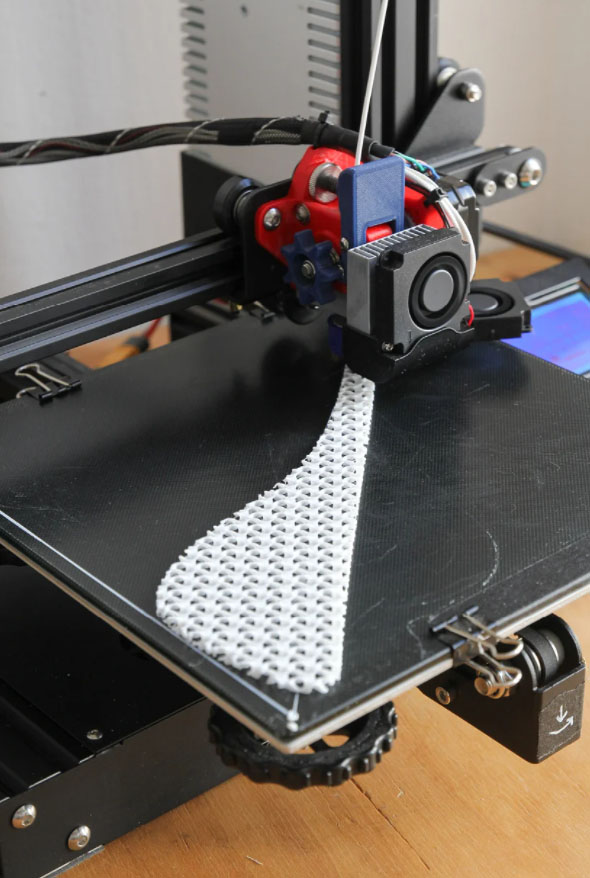Have you ever wondered how a bike saddle might fit or be constructed if we took gender identity out of the equation? Berlin-based industrial designer Tim Schütze has done just that. He created the PRO/CESS 3D printed bike saddle while consciously avoiding any previous standards or preconceived notions of physical characteristics or tastes dependent on gender identity. An algorithmic approach was implemented for the design of the saddle, allowing a fully form-personalized, customizable seat that concentrates on the needs of the user using an open source and adaptive process.
 The PRO/CESS bike seat. Image courtesy of Tim Schültze on Instagram.
The PRO/CESS bike seat. Image courtesy of Tim Schültze on Instagram.Schutze’s ‘PRO/CESS’ is solely based on the algorithmic system to guarantee maximum customizability and flexibility. The necessary information is shaped by the users’ unique data, gathered via app. A 3D model of the user’s rear is generated, employing basic image recognition technology, while additional ergonomic data is extrapolated, and the further preferences are recorded. The padding, size, shape, and design of the saddle in the CAD model is conformed and continually optimized. Print data for fused deposition modeling and selective laser sintering are created and ready for output. Afterwards, the users have multiple choices on how to proceed. They can print the saddle themselves, order the saddle from a micro factory, or even share the data within the maker community.
View this post on Instagram
Schutze is not the first person to take on 3D printed bike seats. 3D printing in the bike market is increasing popularity. In particular, 3D printed bike saddle designs are growing as they are one of the most important parts, being one of only 3 parts of the bike that meets your body. In 2020, Specialized partnered with Carbon to produce their own 3D printed saddle, the Adaptive, which combined the use of a carbon composite base with a polymer lattice design. Also involved in the project was Fizik, who used Carbon’s process to 3D print the padding for the Adaptive seat.
The group focused on the areas of comfort, stability, power transfer and shock absorption—areas where they felt they could improve the manufacturing process. Similar to PRO/CESS, the trio used an adaptive design to the saddle. However, instead of customizing it to each individual user, nine-years’ worth of pressure mapping data from professional cyclists informed the seat’s design.
 An FDM printer making the PRO/CESS. Image courtesy of Tim Schültze on Instagram.
An FDM printer making the PRO/CESS. Image courtesy of Tim Schültze on Instagram.The PRO/CESS took a gender-sensitive approach over the conventional perception of ‘male’ and ‘female’ saddles by being fluid in form. The design is targeted to the individual rather than a data subset from multiple users. The saddle focuses on flexibility and participation, which allows it to nimbly respond to external influences and feedback and adapt complete customization through possible additive manufacturing. (insert image process.jpg)
“In this way, standards of gender differentiation become obsolete and non-binary,” said Tim Schütze.
This strategy was created on a design theoretical study (DTS) in which the social construct of gender identities and the approach to gender equality was based on practical and literature examples to form productive designs. PRO/CESS demonstrates how possible and incumbent gender equality, inclusion, and diversity empowerment is in the medium of design activity. Neither Schütze or the project assert that they have the definitive results or that the project is finalized. The methodology targets a future that is free from binary, heteronormative gender constructs or virtually impeded by supposed gender standards. It is predicated on cultivating discourse and to query the fashion in which gender is (not) factored into design.
Subscribe to Our Email Newsletter
Stay up-to-date on all the latest news from the 3D printing industry and receive information and offers from third party vendors.
You May Also Like
3D Printing Unpeeled: New Arkema Material for HP, Saddle and Macro MEMS
A new Arkema material for MJF is said to reduce costs per part by up to 25% and have an 85% reusability ratio. HP 3D HR PA 12 S has been...
3D Printing News Briefs, January 20, 2024: FDM, LPBF, Underwater 3D Printer, Racing, & More
We’re starting off with a process certification in today’s 3D Printing News Briefs, and then moving on to research about solute trapping, laser powder bed fusion, and then moving on...
3D Printing Webinar and Event Roundup: December 3, 2023
We’ve got plenty of events and webinars coming up for you this week! Quickparts is having a Manufacturing Roadshow, America Makes is holding a Member Town Hall, Stratafest makes two...
Formnext 2023 Day Three: Slam Dunk
I’m high—high on trade show. I’ve met numerous new faces and reconnected with old friends, creating an absolutely wonderful atmosphere. The excitement is palpable over several emerging developments. The high...































